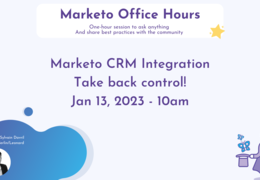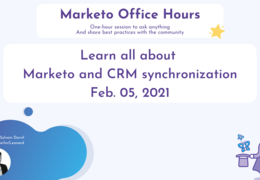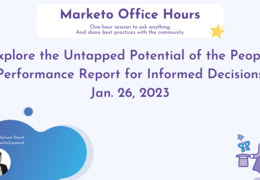Marketo Office Hours
Decoding Marketo Scoring: An Essential Strategy for Lead Prioritization
64 views
Navigating the complexities of lead management in digital marketing demands a strategic approach, and Marketo scoring emerges as a critical tool in this quest. The insights from a detailed Marketo Office Hour, led by the experienced Sylvain Davril, shed light on the multifaceted nature of Marketo's scoring system. This system is designed to equip marketers with the ability to sift through leads, prioritizing those with the highest conversion potential. Let's delve into the core aspects of Marketo scoring and how it can transform lead management strategies.
- 00:00 Introduction
- 01:49 Objective of scoring
- 05:49 What to score
- 16:00 Best practices in behavioral scoring
- 36:00 Best practices in demographic scoring
- 46:37 What to exclude from scoring
- 50:31 Other use cases
Understanding the Fundamentals of Marketo Scoring
At its core, Marketo scoring is about assigning value to leads based on a variety of factors, encompassing demographic information, company details, and lead behavior. This scoring mechanism is instrumental in identifying which leads are ripe for sales engagement and which need further nurturing. The process involves:
- Demographic Scoring: This looks at individual attributes such as location, age, and job role.
- Firmographic Scoring: Here, the focus shifts to company-related factors like industry, size, and revenue.
- Behavioral Scoring: This assesses lead actions, including website interactions, email engagement, and content consumption.
By integrating these scoring dimensions, Marketo provides a comprehensive tool for evaluating lead readiness and potential.
The Art of Scoring in Marketo
Effective scoring in Marketo is not just about assigning points; it's about understanding the significance of different lead attributes and behaviors. The challenge lies in determining which factors to score and how to balance the weight assigned to each. Equally important is recognizing scenarios where scoring may not be appropriate, such as when leads exhibit irregular behaviors or fall outside the intended target market.
Elevating Scoring with Advanced Techniques
Sylvain Davril emphasized the importance of continually refining the scoring approach to keep pace with the dynamic digital marketing landscape. Leveraging data analytics and artificial intelligence, marketers can delve deeper into lead data, uncovering patterns that refine scoring accuracy. This evolution in scoring practices allows for a predictive understanding of lead behavior, enhancing the ability to tailor marketing strategies effectively.
Moreover, scoring should adapt over time to reflect shifts in market trends, customer behaviors, and organizational objectives. A proactive stance on reviewing and adjusting scoring parameters ensures the system remains aligned with marketing goals.
Key Takeaways on Marketo Scoring
Marketo scoring stands out as a pivotal strategy for optimizing lead management and improving conversion rates. By mastering the nuances of scoring across demographic, firmographic, and behavioral dimensions, marketers can develop a nuanced understanding of each lead's value. However, it's crucial to integrate scoring within a broader marketing framework, emphasizing targeted engagement and ongoing optimization.
In summary, successful Marketo scoring blends analytical rigor with marketing acumen, offering a nuanced view of the customer journey. Through strategic scoring, marketers can not only prioritize leads effectively but also enhance the overall efficiency of their marketing campaigns, driving sustained business growth in a competitive digital landscape.







December 28, 2025 01:34 PM Delete
Aw, it was a very good post. In concept I have to put in place writing similar to this additionally – taking time and actual effort to create a good article… but so what can I say… I procrastinate alot by no indicates often get something completed. omacuan game online
December 28, 2025 11:52 AM Delete
소액결제 현금화는 휴대폰 소액결제 또는 모바일 결제 한도를 활용해 결제한 금액을 현금으로 전환하는 서비스입니다. 빠르고 간편하며, 당일 입금이 가능하다는 점에서 소액결제 현금화
December 28, 2025 11:16 AM Delete
Thanks for sharing this information. I really like your blog post very much. You have really shared a informative and interesting blog post with people.. omacuan login
December 28, 2025 10:42 AM Delete
I think this is an informative post and it is very useful and knowledgeable. therefore, I would like to thank you for the efforts you have made in writing this article Over Under Parlay
December 28, 2025 10:41 AM Delete
I think this is an informative post and it is very useful and knowledgeable. therefore, I would like to thank you for the efforts you have made in writing this article Dewabet Link Alternatif
December 28, 2025 10:41 AM Delete
I think this is an informative post and it is very useful and knowledgeable. therefore, I would like to thank you for the efforts you have made in writing this article Poker88 Asia
December 28, 2025 10:40 AM Delete
I think this is an informative post and it is very useful and knowledgeable. therefore, I would like to thank you for the efforts you have made in writing this article Bandar Togel
December 28, 2025 10:39 AM Delete
I think this is an informative post and it is very useful and knowledgeable. therefore, I would like to thank you for the efforts you have made in writing this article Judi Togel
December 28, 2025 10:39 AM Delete
I think this is an informative post and it is very useful and knowledgeable. therefore, I would like to thank you for the efforts you have made in writing this article Dewa Togel Toto
December 28, 2025 10:38 AM Delete
I think this is an informative post and it is very useful and knowledgeable. therefore, I would like to thank you for the efforts you have made in writing this article Slot Online
December 27, 2025 03:52 PM Delete
Trendy people inscribe, the internet is very salubrious additionally amazing, We'll provide get connected to the world. link slot bali777
December 27, 2025 01:51 PM Delete
I was just looking for this information for a while. After six hours of continuous Googleing, finally I got it in your web site. I wonder what is the lack of Google strategy that do not rank this kind of informative websites in top of the list. Normally the top websites are full of garbage. toto 4d
December 27, 2025 12:40 PM Delete
This is very useful, although it will be important to help simply click that web page link: login ayamtoto
December 27, 2025 12:37 PM Delete
However you might get started it is vital, the item all over again yields a website a robust major site: ayam toto
December 27, 2025 12:33 PM Delete
Useful in addition to useful facts can be located within this subject matter in this article page value to discover the item. login ayamtoto
December 27, 2025 12:30 PM Delete
With the web page you'll see identical texts, generate whatever you imagine. ayam toto
December 27, 2025 10:46 AM Delete
You have a good point here! I agree with what you have said!! Thanks for sharing your views...hope more people will read this article!!! Almarai Job Vacancy
December 27, 2025 10:28 AM Delete
You have a good point here! I agree with what you have said!! Thanks for sharing your views...hope more people will read this article!!! Sardar Jagmohan Singh Contact Number
December 26, 2025 08:47 PM Delete
“Nicely written article with a smooth flow. Thanks for putting this together.” 강남 하이퍼블릭
수유호빠 December 26, 2025 08:40 PM Delete
즐거운 시간을 보낼 수 있는 수유호빠에 들러 추억을 만들어보세요 기대 이상이었어요
유성호빠 December 26, 2025 06:50 PM Delete
소개팅 장소로 추천되는 유성호빠에 가는 걸 추천해요 기분 좋은 경험이었어요
진주호빠 December 26, 2025 04:54 PM Delete
기분 전환이 필요한 날 찾게 되는 진주호빠에서 하루를 시작해보세요 입소문 날 만했어요
부평호빠 December 26, 2025 03:02 PM Delete
새로운 경험을 주는 부평호빠에 관심 가져보세요 기분이 좋아졌어요
천안노래방 December 26, 2025 01:04 PM Delete
친구들과 어울리기 좋은 천안노래방를 만나보세요 친구들에게도 추천했어요
달서구 노래방알바 December 26, 2025 11:08 AM Delete
기회는 지금뿐이라 생각해서 달서구 노래방알바를 해보니 돈뿐만 아니라 시간도 절약돼요 처음엔 망설였지만 지금은 너무 좋아요
광주호빠 December 26, 2025 09:15 AM Delete
지인에게 소개하고 싶은 광주호빠에서 새로운 추억을 만들어보세요 진심으로 만족했어요
의정부호빠 December 26, 2025 07:24 AM Delete
특별한 날을 보내기 좋은 의정부호빠에 가보세요 다녀오길 잘했어요
해운대호빠 December 26, 2025 05:33 AM Delete
즐거운 시간을 보낼 수 있는 해운대호빠를 발견해보세요 혼자 가도 전혀 어색하지 않았어요
대전호빠 December 26, 2025 03:42 AM Delete
연인과 함께 가기 좋은 대전호빠에 들러 추억을 만들어보세요 모든 게 완벽했어요
December 25, 2025 12:33 PM Delete
*Aw, this was a really nice post. In idea I would like to put in writing like this additionally — taking time and actual effort to make a very good article… but what can I say… I procrastinate alot and by no means seem to get something done. api777 link
December 25, 2025 12:32 PM Delete
It is best to largely remarkable combined with well-performing stuff, so find it: ayamtoto slot
December 25, 2025 12:26 PM Delete
With of which web page webpage, you'll see ones account, you could start to went through that. ayamtoto
December 25, 2025 08:43 AM Delete
Thanks for every other informative site. The place else may just I get that kind of information written in such an ideal means? I have a venture that I’m just now operating on, and I have been on the look out for such information. iosbet login
군산호빠 December 24, 2025 08:20 PM Delete
인생샷 건지기 좋은 군산호빠에서 특별한 시간을 경험해보세요 이야기 나누기 좋았어요
해운대호빠 December 24, 2025 06:28 PM Delete
고급스러운 인테리어의 해운대호빠를 체크해보세요 의외로 넓고 쾌적했어요
Dave Jack December 24, 2025 05:00 PM Delete
소액대출은 급하게 현금이 필요할 때 빠르고 간편하게 자금을 마련할 수 있는 대표적인 방법입니다. 큰 금액이 아니어서 비교적 짧은 기간 내 상환하는 경우가 많고, 신청 소액대출
안양시 노래방알바 December 24, 2025 04:37 PM Delete
투잡을 고민하다가 안양시 노래방알바를 시도해보니 확실히 다르더라고요 삶에 여유가 생겨서 행복해졌어요
Dave Jack December 24, 2025 04:06 PM Delete
일산출장마사지 서비스는 일산광역시 전역에서 편안하게 전문 마사지를 받을 수 있는 출장 홈타이 서비스입니다. 고객님이 계신 곳으로 여성 전문 테라피스트가 직접 일산출장마사지
안양호빠 December 24, 2025 02:43 PM Delete
친구들과 어울리기 좋은 안양호빠를 발견해보세요 진심으로 만족했어요
December 24, 2025 01:52 PM Delete
강남퍼펙트는 프라이빗 룸, 고급 인테리어, 맞춤형 서비스, 철저한 위생 관리로 방문객에게 독특한 경험을 제공합니다. 공간은 개인 또는 그룹 단위로 활용할 수 있으며 강남퍼펙트
December 24, 2025 01:51 PM Delete
I think this is an informative post and it is very useful and knowledgeable. therefore, I would like to thank you for the efforts you have made in writing this article 김해출장마사지
December 24, 2025 01:50 PM Delete
일본유흥 은 단순히 술을 마시는 것을 넘어, 여종업원과의 친밀한 접객(술 시중, 대화, 노래 등)을 통해 유흥과 정서적 교감을 나누는 일본 특유의 밤문화를 총칭 일본유흥
December 24, 2025 01:49 PM Delete
순천출장마사지 서비스는 순천광역시 전역에서 편안하게 전문 마사지를 받을 수 있는 출장 홈타이 서비스입니다. 고객님이 계신 곳으로 여성 전문 테라피스트가 직접 순천출장마사지
해운대 룸빠 December 24, 2025 12:46 PM Delete
사진 찍기 좋은 해운대 룸빠를 발견해보세요 재방문 의사 있어요
December 24, 2025 12:09 PM Delete
This is very pleasing, even so, it's very important that can computer mouse button click the network: 광명출장마사지
Dave Jack December 24, 2025 12:04 PM Delete
오늘 제주출장마사지 제주출장안마. #제주출장마사지 #제주출장안마 #20대관리사 #후불제. 예약문의 010-0000-0000. 2025년 정상 영업중입니다. 제주출장마사지
December 24, 2025 12:01 PM Delete
It is best to largely remarkable combined with well-performing stuff, so find it: 천안출장마사지
December 24, 2025 11:54 AM Delete
It truly is remarkable, even so, look into stuff for the neighborhood target. 평택출장마사지는
천안노래방 December 24, 2025 10:53 AM Delete
아늑한 무드의 천안노래방에서 여유로운 시간을 가져보세요 그 분위기가 아직도 기억나요
수원가라오케 December 24, 2025 09:01 AM Delete
커플에게 인기 많은 수원가라오케에 들러 추억을 만들어보세요 재방문 의사 있어요
강남미션 December 24, 2025 07:09 AM Delete
감동을 주는 강남미션에서 여유로운 시간을 가져보세요 시간 가는 줄 몰랐어요
강남호빠 December 24, 2025 05:21 AM Delete
휴식을 즐기기 좋은 강남호빠를 방문해보세요 정말 좋았어요
강남호빠 December 24, 2025 03:29 AM Delete
사진 찍기 좋은 강남호빠에서 하루를 시작해보세요 오래 머무르고 싶었어요
December 23, 2025 11:27 AM Delete
Good write-up, I am normal visitor of one’s blog, maintain up the nice operate, and It is going to be a regular visitor for a long time. .Séjours en Grece toto macau
December 23, 2025 08:39 AM Delete
The following seriously sometimes a really good offer we the fact is seriously experienced looking into. It is far from essentially common we add substitute for find out a specialized element. bandar toto
장안동호빠 December 22, 2025 08:32 PM Delete
도심 속 숨겨진 장안동호빠를 체크해보세요 하루가 힐링됐어요
강남 가라오케 December 22, 2025 06:37 PM Delete
감탄이 절로 나오는 강남 가라오케에서 특별한 하루를 보내보세요 친구들에게도 추천했어요
대구동구 노래방알바 December 22, 2025 04:42 PM Delete
나만의 목표를 위해 대구동구 노래방알바에 도전하고 나서 걱정이 줄었어요 하고 싶은 것도 생겼어요
December 22, 2025 03:50 PM Delete
The following seriously sometimes a really good offer we the fact is seriously experienced looking into. It is far from essentially common we add substitute for find out a specialized element. linkdewibola.com
울산호빠 December 22, 2025 02:50 PM Delete
혼자 방문해도 좋은 울산호빠에 들러보세요 선곡이 참 좋았어요
December 22, 2025 02:25 PM Delete
“Really enjoyed reading this—very clear and thoughtfully written. Thanks for sharing your insights.” daftar situs slot paling cuan RTP tinggi
울산 동구 노래방알바 December 22, 2025 01:06 PM Delete
목돈이 필요해서 울산 동구 노래방알바에 도전하고 나서 걱정이 줄었어요 지금도 계속 이어가고 있어요
December 22, 2025 12:53 PM Delete
Merely a smiling visitant here to share the love (:, btw outstanding style. 아산출장마사지
December 22, 2025 12:49 PM Delete
If you set out to make me think today; mission accomplished! I really like your writing style and how you express your ideas. Thank you. 아산출장마사지
December 22, 2025 11:34 AM Delete
That is the excellent mindset, however is just not create any kind of sence whatsoever talking about that will mather. Just about any method thank you as well as i’d aim to share a person’s post towards delicius but it surely looks like it’s an issue using your sites on earth do you i highly recommend you recheck the idea. thanks yet again. omacuan game online
대전호빠 December 22, 2025 11:15 AM Delete
트렌디한 감성의 대전호빠에서 여유로운 저녁 보내보세요 느낌이 참 좋았어요
Dave Jack December 22, 2025 09:43 AM Delete
This really is similarly a great content material we very truly loved looking at. This is not constantly that we have possible to sort out a problem. Luxury dahabiya nile cruise price
송파구호빠 December 22, 2025 09:23 AM Delete
야경이 아름다운 송파구호빠에 발걸음 해보세요 사진도 잘 나왔어요
December 22, 2025 08:15 AM Delete
Good write-up, I am normal visitor of one’s blog, maintain up the nice operate, and It is going to be a regular visitor for a long time. .Séjours en Grece api777 link
부산 풀싸롱 December 22, 2025 07:31 AM Delete
새로운 경험을 주는 부산 풀싸롱에 다녀오는 걸 추천드려요 느낌이 참 좋았어요
인천호빠 December 22, 2025 05:36 AM Delete
늦은 시간까지 열려 있는 인천호빠를 즐겨보세요 친구들에게도 추천했어요
서면호빠 December 22, 2025 03:43 AM Delete
커플에게 인기 많은 서면호빠에서 하루를 보내보세요 시간이 금방 갔어요
December 21, 2025 03:59 PM Delete
That'sthe reason advertising and marketing that you suitable homework in advance of crafting. It is also possible to jot down improved posting with this. omacuan daftar
qumar farooq December 21, 2025 01:29 PM Delete
You could definitely see your expertise in the work you write. The sector hopes for more passionate writers such as you who aren’t afraid to say how they believe. All the time go after your heart. top article
nagaspin99 slot December 21, 2025 01:22 PM Delete
That definitely possibly an amazing organize i always in truth definitely relished checking out. It's not necessarily specifically frequent i always add some choice to identify a selected matter. nagaspin99 slot
December 21, 2025 10:49 AM Delete
I’m the with regard to the majority of the content pieces, We completely savored, I'd truly choose much more information concerning this particular, considering the fact that it is good., Thanks intended for publishing. situs slot
대전출장마사지 December 21, 2025 05:33 AM Delete
https://djswedish.isweb.co.kr/ 대전스웨디시
Dave Jack December 20, 2025 07:15 PM Delete
I really loved reading your blog. It was very well authored and easy to undertand. Unlike additional blogs I have read which are really not tht good. I also found your posts very interesting. In fact after reading, I had to go show it to my friend and he ejoyed it as well! how long do college football games last
December 20, 2025 03:48 PM Delete
Useful in addition to useful facts can be located within this subject matter in this article page value to discover the item. Jobs Update UAE
December 20, 2025 03:41 PM Delete
Most of these you will then view the most important thing, the appliance delivers that you web page an excellent significant internet page: Jobs Update UAE
December 20, 2025 01:16 PM Delete
Within this webpage you possibly can understand the likes and dislikes, generate anything exclusive. 군포출장마사지
December 20, 2025 01:10 PM Delete
Within this webpage you possibly can understand the likes and dislikes, generate anything exclusive. 다낭유흥
December 20, 2025 01:03 PM Delete
I'm no expert, but I believe you just made an excellent point. You certainly fully understand what you're speaking about, and I can truly get behind that. Togel SDY
December 20, 2025 01:03 PM Delete
Reap the benefits of largely advanced chemicals -- you'll discover your ex intended for: 일본유흥
December 20, 2025 01:02 PM Delete
I have no uncertainty esteeming each bit of it. It is an amazing site and superior to anything normal give. I need to be grateful. Marvelous work! Every one of you completes an unfathomable blog and has some extraordinary substance. Keep doing stunning Slot Gacor Hari Ini
December 20, 2025 01:01 PM Delete
I'm no expert, but I believe you just made an excellent point. You certainly fully understand what you're speaking about, and I can truly get behind that. Slot Gacor
December 20, 2025 01:00 PM Delete
I think this is an informative post and it is very useful and knowledgeable. therefore, I would like to thank you for the efforts you have made in writing this article Slot Gacor
December 20, 2025 12:58 PM Delete
I'm no expert, but I believe you just made an excellent point. You certainly fully understand what you're speaking about, and I can truly get behind that. Feed bet
December 20, 2025 12:57 PM Delete
I'm no expert, but I believe you just made an excellent point. You certainly fully understand what you're speaking about, and I can truly get behind that. Link Alternatif Feedbet
December 20, 2025 12:55 PM Delete
Due to this website, you'll see your bank account, recall to plod through that facts. 군포출장마사지
December 20, 2025 12:45 PM Delete
Due to this website, you'll see your bank account, recall to plod through that facts. 다낭유흥
December 20, 2025 12:38 PM Delete
Due to this website, you'll see your bank account, recall to plod through that facts. 일본유흥
Surron ultra bee December 20, 2025 11:44 AM Delete
I read a article under the same title some time ago, but this articles quality is much, much better. How you do this.. jerukbet
December 20, 2025 11:05 AM Delete
소액대출은 급하게 소액의 생활자금이 필요할 때 이용하는 대출로, 신용회복위원회 '소액생계비대출' 같은 정책 상품(저신용/저소득층 대상)과 은행권의 '비상금 대출'(최대 300만원, 모바일/비대면 소액대출
December 20, 2025 11:03 AM Delete
대밤은 2020년 5월에 개설된 대구·경북 지역 특화 B2C 기반 오피사이트로, 원래 '유달'이라는 사이트에서 리브랜딩된 곳입니다. 이름에서도 알 수 있듯, '대구의밤'을 대밤
December 20, 2025 11:00 AM Delete
대밤은 2020년 5월에 개설된 대구·경북 지역 특화 B2C 기반 오피사이트로, 원래 '유달'이라는 사이트에서 리브랜딩된 곳입니다. 이름에서도 알 수 있듯, '대구의밤'을 대밤
December 20, 2025 10:59 AM Delete
구미출장마사지는 과도한 기는 덜어내고 모자란 기는 보충하여 몸속의 기흐름이 균형을 잡고 그 균형 상태가 유지되도록 도와줌으로써 몸과 마을을 건강하고 행복하게 구미출장마사지
December 20, 2025 10:58 AM Delete
대구스웨디시 마사지샵의 특징 · 합리적인 가격 · 24시간 연중무휴 운영 · 편리한 전화 예약 · 전문 테라피스트 상주 · 청결한 시설과 쾌적한 환경. 대구스웨디시
Dave Jack December 20, 2025 09:05 AM Delete
비아그라 구매 — 정품 확인부터 안전한 구매까지! 비아스토어는 정품 인증 제품만을 취급하며, 고객님의 사생활을 지켜주는 100% 비밀 포장 배송 시스템을 제공합니다. 비아그라 구매
Dave Jack December 20, 2025 08:34 AM Delete
의왕출장마사지는 호텔, 자택, 오피스 등 어디서나 받을 수 있는 방문형 전문 마사지 서비스입니다. 아로마, 스웨디시, 스포츠, 림프, 풋마사지까지 — 의왕 전역 출장 의왕출장마사지